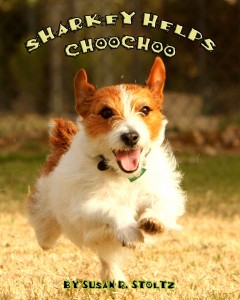By Bianca Schulze, The Children’s Book Review
Published: March 17, 2011

The Adventures of Sharkey the Dog is a series of books written for children ages 3 – 6—a percentage of the profits go to animal help groups. Would you mind sharing the compelling, real-life story that inspired you to begin writing this series for children?
A year ago a careless pharmacist overdosed my little Jack Russell Sharkey by 10 X the amount prescribed. We almost lost her that night and she suffered liver damage in which it took her a year to recover. During that time I was fighting with the grocery store chain that owned the pharmacy, the insurance companies, etc. Fighting corporate America who cares only for the bottom line and not what is ‘right’ is a losing battle. It became apparent that the negativity was engulfing our lives and I had to make a choice. Did I want to be right or did I want to be happy. So I tried to find a way to turn the negativity into something positive that could benefit other animals in need. Writing children’s books with Sharkey as the center focus seemed a natural way to approach subjects important to children who learn so readily from animals. This also made it possible to donate to animal rescue groups.
How is Sharkey doing now?
Sharkey is doing well. It took a year for her liver enzymes to return to normal. It was a long struggle but well worth the time, stress and heartache involved. She’s such a loving and giving little package of fur. Because she’s such a small Jack Russell she maintains that look of a puppy and endears almost all who see her. The children just can’t seem to get enough of her.
It is no wonder that you felt compelled to turn Sharkey’s misfortune around by sharing important life lessons with children. Which topics have you covered so far?
 The first book ‘Sharkey Meets Kittyhead’ is all about two very different animals learning to share the same space. Diversity is a tough topic for all of us, but to talk about it through the eyes of Sharkey and Kittyhead seemed a very low key and natural way to approach the subject while recognizing and validating feelings and offering alternatives. The next book ‘Sharkey Helps ChooChoo’ approaches the topic of bullying, a very prevalent subject in our society. The animals, again, tell the story well and offer children good solutions with the help of the adults in their lives. The third in the series is ‘Sharkey Learns to Swim’ and discusses fear, something, to which all children can relate. The fourth in the Sharkey books is about sharing. We also have a book tucked into the middle of these entitled ‘ChooChoo Likes to Sleep’ which is a fun book about little ChooChoo who falls asleep everywhere she goes.
The first book ‘Sharkey Meets Kittyhead’ is all about two very different animals learning to share the same space. Diversity is a tough topic for all of us, but to talk about it through the eyes of Sharkey and Kittyhead seemed a very low key and natural way to approach the subject while recognizing and validating feelings and offering alternatives. The next book ‘Sharkey Helps ChooChoo’ approaches the topic of bullying, a very prevalent subject in our society. The animals, again, tell the story well and offer children good solutions with the help of the adults in their lives. The third in the series is ‘Sharkey Learns to Swim’ and discusses fear, something, to which all children can relate. The fourth in the Sharkey books is about sharing. We also have a book tucked into the middle of these entitled ‘ChooChoo Likes to Sleep’ which is a fun book about little ChooChoo who falls asleep everywhere she goes.
 How many books will be in the series?
How many books will be in the series?
I’m uncertain at this point. As long as pertinent subject matter continues to present itself I think we’ll continue the series. It’s interesting that while shooting the photos for one book, another topic will present and we just roll with it.
Photographs taken by you for the first book and Suzanne Sylvester for the next few books compliment the stories. How do you go about taking and selecting the pictures that best match the text?
I’ve discovered that this is not as easy as it may seem. We have an outline of the storyline when we go to shoot. I illustrate some key photos that we must have and beyond that we just shoot the animals together. I’m always amazed with the end product. Generally it’s my job to sort through approximately 3,000 photos for each book and narrow that down to about 30. It takes weeks to compare and contrast exactly which photos tell the story well. I also end up altering text to fit in photos that we simply MUST use so it’s a give and take both ways. Suzanne and I work well together in that we trust each other to do our part of the job well. It’s a good partnership.
What has been the most surprising thing you have learned in creating your books?
Children’s books aren’t easy to write. So many people seem to think that a children’s book should be effortless to just whip off. But what they don’t realize is that first you have to have a good understanding about what’s important to the age group for which you’re writing. You also have to have a grasp of their level to understand and appropriate vocabulary. And it needs to be presented for young children in such a way that instills confidence and empathy. Concepts that you and I take for granted aren’t so evident to the young. It’s a tricky task to write a message – but even trickier to keep their attention.
When you hear from your readers, what kinds of things do they say?
I’ve had such positive feedback from not only my young readers but from adults as well. In a recent radio interview the host said that she had guests over the weekend and they all passed Sharkey’s book around several times. Charm seems to be one of the favorite characters in the book with her wise words of wisdom. Children want to know if Sharkey and Kittyhead are good friends in real life and it’s fun for me to assure them that the two are inseparable. They also want to know when the next book will be ready!
Prior to writing your children’s books about Sharkey, you were a journalist. Have you always considered yourself a writer?
No, actually, writing is something that has come about later in life for me. I’ve contributed to newsletters and smaller publications in the past, but it wasn’t until I was extremely unhappy in my job as a real estate appraiser that I made a decision to publish a magazine and landed the subsequent job writing a by-line for a Wyoming newspaper. I published a collection of short stories about my adventures as an appraiser – “The Part-Time Thief and Other Appraisal Stories” available on Amazon – and was working on another project when the situation with Sharkey necessitated a sharp turn down my path as an author.
When you’re not writing, you are advocating for animal rights. What would be the first steps for young readers who would like to join your crusade?
I don’t consider myself an animal rights activist. I’m very involved with animal rescue, the difference being that I actually work with rescued animals to help them find a new life and a new home. The job description as an ‘activist’ entails too much negativity that I was trying to turn around in my writing this series. And although at the rescue we deal with so many very sad stories and abandoned animals it’s a positive thing to take them and work with their behavior problems and health issues and find them loving and caring homes. I have a real soft spot for senior dogs and am working with AZ JR Rescue to raise funding for a potential project – a senior animals home – so that those elderly Jacks that can’t find a place to live out the rest of their lives have a home, built much like a house complete with sofa’s and chairs, where they will be loved and cared for until they die. The funds for Sharkey’s next book are going toward this effort.
If a family is thinking about getting a pet, young readers can ask that they adopt a pet rather than buying from pet stores or breeders. Adopting a pet is giving a loving and caring animal another chance in this world, another opportunity to be a part of a family and a best friend.
Do you have anything specific that you want to share with your readers?
The importance of reading is a message we try to put in each book. Sharkey has a poem at the end about just that – and a different poem will be in each of the series.
Treating animals with the love and respect they deserve is also an important message for us. We can all learn so much from our animals. They give us great lessons in overcoming fear, in trust, love, and forgiveness. Young children have so many of the same attributes as our animals. If we can teach them to keep those positive characteristics as they grow older, perhaps this generation of children will find it in themselves to solve the problems we have, not only with how we treat animals but in how we treat one another.
The Author Showcase is a place for authors and illustrators to gain visibility for their works. Read more …
